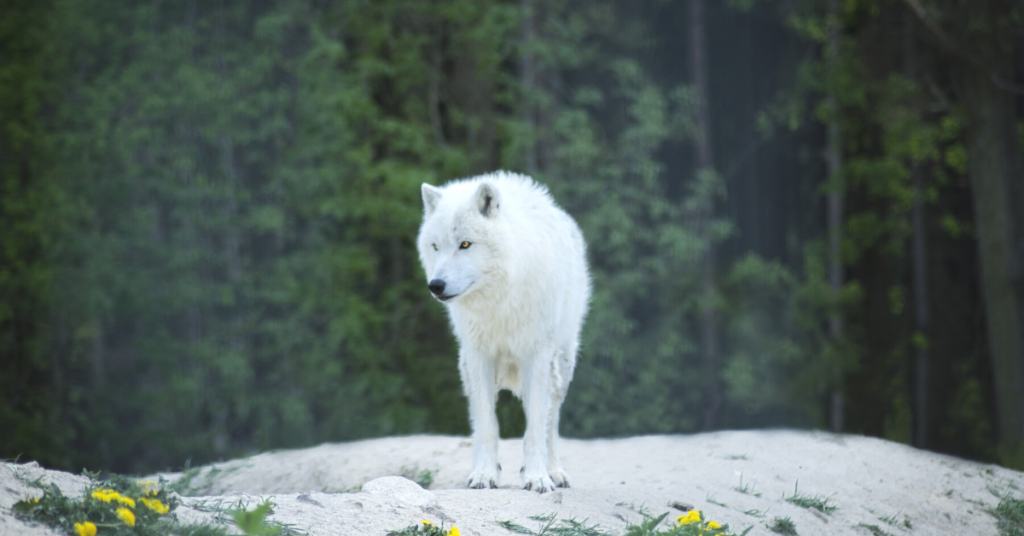Wolves are among the most majestic creatures on earth, with their piercing eyes, powerful bodies, and intricate social structures. They have fascinated people for centuries and inspired myths, legends, and stories. However, for many years people have wondered if wolves have feelings. Do they experience emotions like humans or are they driven purely instinctively? The answer is definitely yes, wolves have feelings.
In fact, research has shown that wolves are highly emotional creatures and their emotional range is strikingly similar to that of humans. Just like us, they experience joy, fear, anger, sadness, and love, among other emotions. One of the most fascinating aspects of wolf emotions is their ability to empathize.
Wolves are incredibly social animals and form strong bonds with their packmates. When one member of the pack is injured or ill, the others often bring him food, nurse him, and offer comfort. They even help them hunt and share their food with them. This shows that wolves are able to understand and respond to the emotions of others, which is a hallmark of empathy.
In addition, wolves have been observed to mourn the loss of pack members. When a wolf dies, the others often howl pitifully, sometimes for hours. They will also visit the place where the deceased wolf died and may even refuse to leave the area for several days. This behavior suggests that wolves have a deep emotional connection with their packmates and feel a sense of loss and sadness when one of them dies.
In addition to empathy and sadness, wolves also experience joy and excitement. They have been observed playing and frolicking with each other, chasing each other’s tails, and engaging in mock fights. They also have a keen sense of curiosity and are known to explore their surroundings and examine new objects.
Finally, wolves are capable of fear and anger, which are often protective emotions that help them defend themselves and their pack. When threatened, wolves will often growl, bare their teeth, and even attack if necessary. However, they also have a strong sense of self-preservation and generally avoid confrontation when they can.
Wolves are not just instinctive animals; They are highly emotional beings with a wide range of feelings and behaviors. Their emotional intelligence and social ties are remarkable and show that they are not all that different from humans. As we learn more and more about these fascinating creatures, it’s important to treat them with the respect and admiration they deserve.
Unfortunately, wolves have long been misunderstood and mistreated by humans. They have been hunted, trapped, and killed for centuries, often for no other reason than fear and ignorance. This has led to significant declines in wolf populations in many areas and even extinction in some regions. However, in recent years there has been a growing movement for the protection and conservation of wolves, recognizing their important role in ecosystems and their right to exist as a species.
Many organizations and individuals work to promote wolf conservation, education, and research to better understand and appreciate these amazing animals. By recognizing that wolves have feelings and emotions, we can begin to see them as more than just predators or nuisances. but as complex beings with their own needs and desires. This can help us develop a more respectful and compassionate attitude toward wolves and work to coexist with them in ways that benefit both humans and the natural world.
Wolves are very emotional animals and their behavior can vary depending on their emotional state. Here are some examples of how wolves may behave in different emotional contexts:
Happiness: When wolves are feeling happy, they may engage in playful behaviors such as chasing, fighting, and jumping. They can also express themselves through playful howling or barking, for example. Wolves can also show playfulness through body language, such as tail wagging and relaxed postures.
Fear – When wolves are feeling fearful, they can become more cautious and alert. They may raise their ears and tail and assume a tense posture. Wolves may also attempt to flee the source of the fear, or if cornered, they may exhibit defensive behaviors such as growls, snarls, or snarls.
Anger: When wolves are angry, they may exhibit aggressive behaviors such as growling or baring their teeth. teeth and jumps forward. Their posture can become more dominant and they can harden their bodies. Aggression is usually shown in defense of themselves or members of their pack.
Sadness – When wolves are sad, they can become more lethargic and less interested in their surroundings. They may howl sadly, visit the place where a pack member died, or show a change in their body language, such as: lowering their head or tail.
Empathy: When wolves show empathy towards their packmates, they can nurture and comfort one another by bringing food and sharing their prey with the sick or injured member of the pack.
In short, wolves exhibit different behaviors based on their emotions. By understanding the behavior and emotions of wolves, we can better appreciate these amazing animals and how they interact with each other and their environment.
Understanding the behavior and emotions of wolves is important not only for the appreciation of these animals but also for conservation efforts. By recognizing the emotional and social nature of wolves, we can develop management strategies that promote healthy wolf populations and mitigate conflicts with humans. For example, some areas have adopted non-lethal methods of managing wolf populations, such as using watchdogs to protect livestock, or electric fences to keep wolves away from human settlements.
By addressing the root cause of conflicts with wolves, rather than simply resorting to lethal measures, we can work toward more sustainable and ethical coexistence with these animals. In addition, understanding the emotions of wolves can inform research efforts as well. Scientists studying wolf behavior can use observations of wolf emotions to gain insight into the inner workings of wolf societies and relationships.
For example, studying empathy in wolves can provide insights into how social bonds form and are maintained within the pack. Overall, understanding wolf emotions is critical for promoting coexistence with these animals, as well as for advancing scientific knowledge about wolf behavior and social structures.
Wolves are highly social and intelligent animals that exhibit a wide range of behaviors that are essential to their survival in the wild. Here are some of the key behaviors that wolves exhibit:
- Pack living: Wolves live in family groups called packs, which typically consist of a dominant breeding pair, their offspring, and sometimes other related individuals. Pack living provides wolves with a number of benefits, including improved hunting success, enhanced protection from predators, and social bonding.
- Communication: Wolves communicate with each other using a variety of vocalizations, body language, and scent marking. Vocalizations include howling, barking, growling, and whining, and are used to coordinate pack activities, announce territorial boundaries, and express emotions. Body language includes tail wagging, ear position, and body posture, and can be used to signal dominance, submission, or aggression.
- Scent marking involves urinating or defecating in a particular location, and can be used to communicate territorial boundaries or to attract mates.
- Hunting: Wolves are skilled hunters that primarily prey on large ungulates such as elk, deer, and moose. They hunt in coordinated packs, using their intelligence, teamwork, and endurance to bring down prey. Wolves may also scavenge from carrion when prey is scarce.
- Territorial behavior: Wolves are territorial animals that defend their pack’s territory from intruders. They may use scent marking, vocalizations, and physical aggression to protect their territory.
- Mating and reproduction: Wolves typically mate for life, and the dominant breeding pair in a pack is responsible for producing offspring. Wolves breed once a year, typically in winter, and produce litters of 4-6 pups. Pups are born blind and helpless and rely on their parents and other pack members for food and protection.
- Play: Wolves, especially young pups, engage in play behavior that helps them develop social skills and physical coordination. Play can involve chasing each other, wrestling, and playing with objects like sticks and balls.
- Adaptability: Wolves are highly adaptable animals that can thrive in a wide range of habitats, from forests to tundra to grasslands. They have adapted to living in many different environments by developing specialized physical and behavioral traits, such as thick coats for cold weather, long legs for traversing deep snow, and social structures that allow them to coordinate hunting and defense.
- Migration: In some areas, wolves may migrate long distances in search of food and suitable habitats. This behavior can be influenced by a variety of factors, including prey abundance, habitat availability, and human disturbance.
- Leadership and hierarchy: Wolves have a hierarchical social structure in which each pack has a dominant alpha pair that leads and directs the other members of the pack. The alpha pair typically makes decisions about where to hunt, when to rest, and how to defend the pack’s territory.
- Parenting and caregiving: Wolves are highly attentive parents that care for their young until they are old enough to fend for themselves. Pack members may also provide caregiving for sick or injured wolves, and may share food with members of the pack that are less successful hunters.
- Intelligence: Wolves are highly intelligent animals that are capable of complex problem-solving, communication, and social interaction. They are able to learn from experience and adapt to changing circumstances and have been observed exhibiting behaviors that suggest they possess advanced cognitive abilities.
- Avoidance behavior: While wolves are often portrayed as aggressive and dangerous animals, they typically exhibit avoidance behavior when encountering humans. This behavior involves wolves retreating or avoiding contact with humans, and is thought to be an adaptation that helps wolves avoid conflicts with humans and reduce their risk of being killed.
- Dispersal behavior: As young wolves mature, they may leave their natal pack and disperse in search of a mate and a new territory. Dispersal behavior can be influenced by a variety of factors, including pack size, prey availability, and habitat quality.
- Social bonding: Wolves are highly social animals that form strong bonds with their pack members. These bonds are essential for pack cohesion and are reinforced through communication, play, and caregiving behaviors.
- Aggression: While wolves typically exhibit avoidance behavior when encountering humans, they may exhibit aggression when defending their territory, their pack, or their young. Aggression can also occur within the pack, as individuals compete for dominance or resources.
- Foraging behavior: Wolves are opportunistic predators that hunt a wide range of prey, from large ungulates to small rodents. They may also scavenge from carrion or feed on plant material during times of scarcity.
- Denning behavior: Wolves typically den in underground burrows or in rock crevices, which provide protection from predators and the elements. Denning behavior is most common during the breeding season when the alpha female gives birth to and cares for her pups.
In conclusion, the behavior of wolves is complex and multifaceted, reflecting the social, ecological, and environmental challenges that these animals face in the wild. Wolves exhibit a wide range of behaviors, from hunting and foraging to social bonding and communication.
By studying wolf behavior, researchers can gain a deeper understanding of these animals, and work to protect and conserve them for future generations.

Erzsebet Frey (Eli Frey) is an ecologist and online entrepreneur with a Master of Science in Ecology from the University of Belgrade. Originally from Serbia, she has lived in Sri Lanka since 2017. Eli has worked internationally in countries like Oman, Brazil, Germany, and Sri Lanka. In 2018, she expanded into SEO and blogging, completing courses from UC Davis and Edinburgh. Eli has founded multiple websites focused on biology, ecology, environmental science, sustainable and simple living, and outdoor activities. She enjoys creating nature and simple living videos on YouTube and participates in speleology, diving, and hiking.
- WILDLIFE THEMED T-SHIRTS
Cute Hedgehog Embroidered: Love Wildlife, Protect Nature Wildlife conservation tees
$35.00







